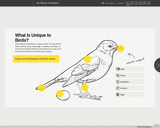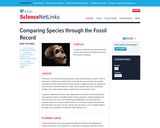
With this interactive tutorial, students explore the evolutionary adaptation of feathers in birds.
- Subject:
- Science
- Material Type:
- Interactive
- Provider:
- The Cornell Lab of Ornithology
- Date Added:
- 08/21/2018

With this interactive tutorial, students explore the evolutionary adaptation of feathers in birds.

Students learn about the amazing evolutionary history of arthropods. The module contains informational text, interactives, and assessments.

Explore the ideas and evidence that helped Charles Darwin create his theory of evolution.
GeoInquiries are designed to be fast and easy-to-use instructional resources that incorporate advanced web mapping technology. Each 15-minute activity in a collection is intended to be presented by the instructor from a single computer/projector classroom arrangement. No installation, fees, or logins are necessary to use these materials and software.

In their study of the medium ground finches, evolutionary biologists Peter and Rosemary Grant were able to track the evolution of beak size twice in an amazingly short period of time due to two major droughts that occurred in the 1970s and 1980s. This activity simulates the food availability during these droughts and demonstrates how rapidly natural selection can act when the environment changes. Students use two different types of tools to represent different beak types to see which is best adapted to collect and eat seeds of different sizes. Students collect and analyze data and draw conclusions about traits that offer a selective advantage under different environmental conditions. They have the option of using an Excel spreadsheet to calculate different descriptive statistics and interpret graphs.


Students will identify the major evolutionary innovations that separate plant divisions, and classify plants as belonging to one of those divisions based on phenotypic differences in plants. They will also classify plants by their pollen dispersal methods using pollen dispersal mapping, and justify the location of a crime scene using map analysis. Students will also be able to analyze and present their analysis of banding patterns from DNA fingerprinting using plants in a forensic context.

Students watch the video "Chordates: We're All Family" and answer a series of questions about adaptations and evolution.

Students trace the evolutionary history of birds by comparing the shapes and structures of certain bones in a chicken to those of some of its extinct and living relatives in this interactive.

In this biology inquiry lab, students study evolutionary relationships by making observations of preserved animal specimens, developing a question, then investigating by dissecting the specimens provided.

Students examine how physical features noted in the fossil record provide clues about the evolution of species.

In this lesson, students watch a video of scientists finding, collecting, and dating fossils. They then answer questions about scientific processes and work with ratios and proportions to solve simple algebraic equations relating to fossil data. Recommended for middle school life/earch science, high school environmental science, or high school biology.

This interactive resource explains how DNA sequences can be used to generate phylogenetic trees, and how to interpret them.

Students read an article describing a study that sheds new light on Charles Darwin's hobby of breeding pigeons. They learn about the origins of genes responsible for certain traits in pigeons, explore how scientists unravel the connections between genes and physical characteristics, and simulate a selective breeding program.

In this lesson, students collect and analyze evidence for each of the major conditions for evolution by natural selection to develop an explanation for how populations change over time. This activity is based on the classic study of the evolution of fur color in rock pocket mouse populations. It supports the short film, “The Making of the Fittest: Natural Selection and Adaptation.†Students summarize the evidence for evolution by natural selection presented in the film and in figures from a scientific paper. They should then be able to apply the same concepts to any trait that changes in response to natural selection in any species. The activity helps students develop useful skills aligned with the science practices of constructing explanations and engaging in argument from evidence.

In this activity, students will "dig" for paper fossils and make observations of various fossils to determine characteristics of chimpanzees and humans. Students will then use their new knowledge to dig up and analyze a new fossil discovery that must be presented, with evidence, to the scientific community (class) during and oral presentation.

Dolphins and other marine mammals have pretty big brains compared to the size of their bodies. That?s one indication of high intelligence, and anyone who has seen them perform at an aquarium or zoo can attest to that fact. This Science Update introduces us to one scientist who?s trying to find out how dolphins got so brainy.

Earth Forms and Life BeginsGiving us credit when you use our content and technology is not just important for legal reasons. When you provide attribution to CK-12 Foundation, you support the ability of our non-profit organization to make great educational experiences available to students around the world.Our Creative Commons License welcomes you to use our content and technology when you give us attribution. If you have any questions about our policies, contact us at support@ck12.org

This feature film describes how the genetic legacy of a fish can be seen today in our own DNA.

This feature film describes how the genetic legacy of repitles can be seen today in our own DNA.

This feature film describes how the genetic legacy of early primates can be seen today in our own DNA.